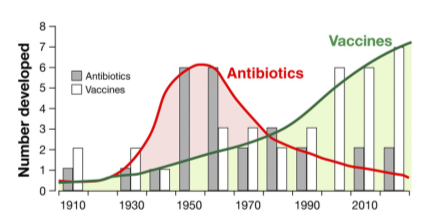Home / Healthcare & Medicine / Antimicrobial & Antibiotic Resistance / The Role of Vaccines in Preventing Infectious Diseases and Antimicrobial Resistance / Role of Vaccines in Preventing and Reducing AMR
This article is from the free online
The Role of Vaccines in Preventing Infectious Diseases and Antimicrobial Resistance


Reach your personal and professional goals
Unlock access to hundreds of expert online courses and degrees from top universities and educators to gain accredited qualifications and professional CV-building certificates.
Join over 18 million learners to launch, switch or build upon your career, all at your own pace, across a wide range of topic areas.

 Schematic representation showing that the use of antibiotics selects for resistance (R), making the antibiotic obsolete. Therefore, a continual pipeline of new antibiotics is needed for effective treatment. In contrast, vaccines can be used for a very long time without generating significant resistance. Reference: Bloom et al. PNAS. Dec 18
Schematic representation showing that the use of antibiotics selects for resistance (R), making the antibiotic obsolete. Therefore, a continual pipeline of new antibiotics is needed for effective treatment. In contrast, vaccines can be used for a very long time without generating significant resistance. Reference: Bloom et al. PNAS. Dec 18
 Vaccines and antibiotics licensed during the last century. Reference: Bloom et al. PNAS. Dec 18.
Vaccines and antibiotics licensed during the last century. Reference: Bloom et al. PNAS. Dec 18.





